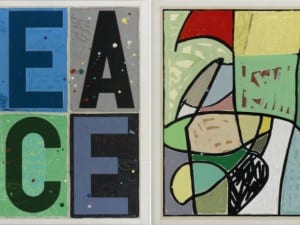A lyrical witticism lies at the heart of Lenny Cornforth’s paintings; her pieces rely on the gentle rhythm of instinctive colour decisions and an unapologetic attention to the potential of aesthetic form.
A: Why do you think that painting is still a relevant and inclusive form of artwork?
LC: I would always maintain that painting has stayed an important area of contemporary art. Despite being subjected to criticisms of “where next” and “what now” for the past decade, painting remains one of a few mediums untarnished by the new millennial’s question, not “what is art” but simply “where is art?” The inclusivity of it means that an audience can ask not just how the work is relevant to contemporary culture but how the world around us can be absorbed, used and changed by it.
A: In contrast to representational styles, you favour abstraction, with bold colours and geometric forms coming together within compositions?
LC: Yes, instead of translating the representational world around me onto the canvas, I prefer to explore the shadier and more ambiguous shapes of abstraction in order to create something that is harder to translate back into the representational world. Relying on bold colours to shape a composition I allow the natural changes on the surface of the painting to inform subsequent aesthetic decisions, creating a new confrontational experience for the viewer.
A: Are you interested in colour theory and, if so, how do you think this feeds into your works?
LC: I always think of it as “the rigorous, simultaneous exercise of intuition and intellect.” A well-honed, and practised process of using the right hues next to each other. Visually, colours can physically appear not as they should, lending a mysterious element of alchemy to the process of mixing and over laying. This is why a fascination with colour feeds so intrinsically into my practice. Oils, pigments and glazes all play a part in how the surface of a canvas will reflect a certain tone back.
A: How do you think that your pieces respond to the two dimensions of the canvas and create a unique space for expression?
LC: The surface of each piece is uniquely suited to the pigments and brush strokes, an attention to canvas preparation and ritual allow each space to be created with due consideration for each painting. Every intention is executed in referral to a subsequent brush stroke, creating a platform for intuitive expression.
A: What intrinsic qualities of painting do you enjoy most and how do you incorporate these into each new piece?
LC: Painting documents the artist’s journey, both physically over the surface of the canvas and introspectively as the painter’s decisions and internal conflicts are brought to the surface of each piece. In my own work, I favour a larger canvas so that this process can be further reflected in my physical exertion across the surface and so that my confrontation with the piece as an artist is as close as possible to the experience of the viewer.
A: Do you think that the process of creating is just as important as its reception? Do you think it matters the expression that goes into a work is often unseen by its viewer?
LC: Creation is always equally important to the viewer’s experience. Process begins a piece and audience announces it finished – “the intimacy between the creation and the creator is ended,” and the work becomes “a revelation, an unexpected and unprecedented resolution.” In this respect, it is less important that an artist’s original expression is seen by the viewer and more important that the viewer experiences their own unique confrontation with the work.
A: How does your series resonate with you on a personal level; is this something you try to replicate in your audiences?
LC: Each series of paintings is a unique reflection of the present tense, thereby resonating with me on a personal level that it might not necessarily extend to the viewer. However, although specific intentions may be hidden, an audience may connect to a painting, reflecting back their own experiences and emotions. On a basic level, they are simply looking at something that you have intentionally created for them to look at; on a more mindful level, I hope that they are connecting to something they may have experienced, that provokes an emotional response within them.
A: How do you begin to plan a piece, is there thought that goes into composition or a particular tone of colour?
LC: A painting will begin as a series of written words, prose or poetry, and colours, allowing intention to bleed into a more organic and instinctive method of working. Often physically starting with one or two hues to shape a composition, my attention will begin entirely on colour and surface, later working towards a more formalist approach. The size of each piece will depend on how much space the composition needs in order to confront the viewer at the right scale.
www.lennycornforth.com
cornforthe@gmail.com
Credits:
1. Curling Steam off Coffee Cups (Couldn’t Keep Me Away). Oil on Canvas. Courtesy of the artist.
2. Deep Velvet. Oil on Canvas. Courtesy of the artist.
3. I Wanted Things That at Times I Couldn’t Articulate. Oil on Canvas. Courtesy of the artist.




